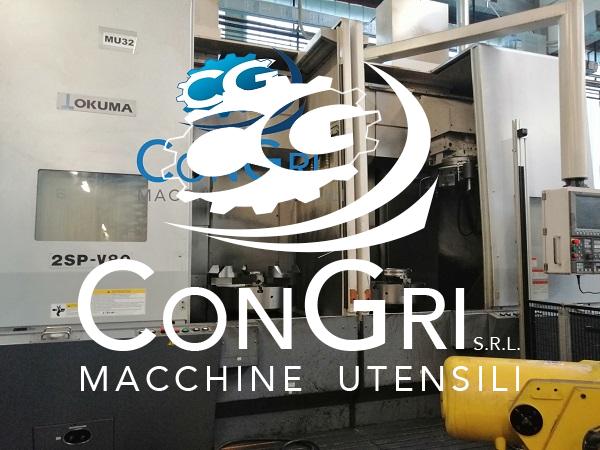Twin-spindle lathes: efficiency and innovation in mechanical machining
When your goal is to reduce machining time without compromising on quality, twin-spindle lathes are one of the most effective solutions for modern manufacturing. By allowing work on both sides of a part in a single setup, these machines minimize downtime, optimize productivity, and enable smoother handling of complex batches. Simultaneous machining on opposing spindles ensures high precision in shorter cycles, helping you boost your shop’s competitiveness.
ConGri S.r.l., an Italian company specializing in the sale of new and reconditioned machine tools, provides customized solutions for twin-spindle lathes as well. With a wide range of selected CNC machines, ConGri supports manufacturers of all sizes with advanced systems tailored to the demands of automation, speed, and flexibility. Choosing the right lathe means investing in efficiency, and understanding how twin-spindle lathes work helps you find the best solution for your production goals.
How twin-spindle lathes work: structure and operating logic
Twin-spindle lathes are designed to perform simultaneous machining on both sides of a single workpiece using two opposing spindles. This setup drastically reduces production times by eliminating the need to transfer the part between machines.
The main spindle performs initial operations such as roughing or threading, while the secondary spindle—also known as the sub-spindle—automatically takes over the part to complete finishing or precision work. Synchronization between spindles is managed by an advanced CNC control, ensuring accuracy and repeatability even for complex cycles.
Structurally, a twin-spindle lathe may feature:
- Motorized turrets for milling and drilling
- Y-axis for off-center holes and asymmetric machining
- Automatic loaders to increase productivity autonomy
- Optimized chip evacuation systems for continuous operation
This architecture supports balanced, multitasking machining that reduces part handling and improves overall efficiency. Integration with robots or automated loading systems further enhances performance, making these lathes ideal for series production, high-precision sectors, and automated industrial environments.
When to choose twin-spindle lathes for your production
Choosing twin-spindle lathes for your shop is a strategic move when your aim is to optimize cycle times, reduce part handling, and boost overall efficiency. These machines are particularly advantageous when your parts require operations on both the front and rear, as they allow complete machining in a single uninterrupted cycle.
If you’re working with medium to large batch sizes or managing repeat orders requiring consistent precision, a twin-spindle lathe enables you to improve productivity without sacrificing quality. They’re also ideal if you need to reduce setup times or eliminate repositioning errors between machining phases.
The choice becomes even more compelling if you’ve already introduced automation into your workflow or are planning to. A twin-spindle lathe integrated with automated loading and unloading systems supports continuous cycles, ideal for just-in-time production or extended shifts with limited supervision. If you’re operating in industries like automotive, precision mechanics, or industrial components, you’ll benefit from lower per-part costs and improved dimensional stability from complete in-machine processing.
Twin-spindle lathes and automation: a winning combination
When automation is part of your strategy, integrating twin-spindle lathes into your production line can deliver significant benefits in terms of efficiency, uptime, and cost per part. The dual-spindle setup aligns perfectly with automated systems, managing multiple machining phases without manual part handling, which boosts overall productivity.
Combining twin-spindle lathes with automation allows you to:
- Reduce idle time between operations by machining both sides in a single cycle
- Optimize workflow, especially when using robotic loaders or automated storage
- Ensure continuous production, even with limited operator supervision
- Minimize human error through automated handling and positioning
- Improve traceability and quality control with integrated sensors and vision systems
This approach is ideal for high-volume jobs, tight tolerances, or complex parts that demand consistent precision. An automated setup with twin-spindle lathes also frees up your skilled workforce from repetitive low-value tasks, letting them focus on high-level operations and decision-making. If your goal is to make your production faster, smarter, and more competitive, this is one of the most effective strategies.
Choosing new or reconditioned twin-spindle lathes with ConGri S.r.l.
When considering twin-spindle lathes, one of the most important decisions is whether to invest in a new or reconditioned machine. Both options offer strong advantages, as long as they align with the actual needs of your production. ConGri S.r.l., an expert in the sale of new and reconditioned machine tools, supports you with a detailed technical evaluation to help you find the most effective solution.
A new twin-spindle lathe is the ideal choice if you seek cutting-edge technology, maximum precision, and full compatibility with advanced automation systems. It’s a strategic investment for growing businesses focused on high-volume, continuous production with strict quality standards.
If you’re looking to control costs without compromising on performance, a reconditioned twin-spindle lathe can be a winning choice. ConGri S.r.l. offers only carefully inspected machines, updated mechanically and electronically, and ready for seamless integration into your production cycles.
Thanks to direct field experience and a deep understanding of industrial processes, ConGri is a trusted partner for smart investment decisions, helping you balance performance, cost, and operational continuity.
Click here to get in touch and learn more!
Frequently asked questions about twin-spindle lathes
What are the main advantages of twin-spindle lathes compared to traditional lathes?
Twin-spindle lathes can machine both sides of a part simultaneously, drastically reducing production times. They offer higher productivity, better workload balancing, and complete machining in a single setup.
When is it worth investing in a twin-spindle lathe?
A twin-spindle lathe is ideal for medium-to-large batches, symmetrical parts, or cycles that require operations on both ends. It’s also great if you want to increase automation without sacrificing quality.
Are twin-spindle lathes compatible with automated systems?
Yes, they integrate easily with robotic loaders, automated storage, and advanced CNC systems, making them perfect for high-efficiency automated work cells.
Are there reliable used twin-spindle lathes available?
ConGri S.r.l. selects and refurbishes used twin-spindle lathes to high standards, offering cost-effective, high-performance alternatives without compromising reliability or accuracy.
What materials can be machined with twin-spindle lathes?
These lathes can handle a wide range of materials, including steel, light alloys, brass, aluminum, and technical plastics, with excellent precision and consistency.

